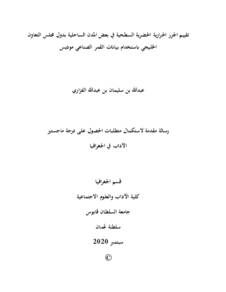Document
تقييم الجزر الحرارية الحضرية السطحية في بعض المدن الساحلية بدول مجلس التعاون الخليجي باستخدام بيانات القمر الصناعي موديس.
Other titles
Assessment of Surface Urban Heat Islands in Some Costal Cities of the GCC Countries Using MODIS LST Data
Publisher
جامعة السلطان قابوس.
Gregorian
2020
Language
Arabic
Subject
English abstract
The urban heat island (UHI) effect is the most obvious atmospheric modification
related to urbanization and development. During the past twenty years, the Gulf
Cooperation Council (GCC) states (KSA, Kuwait, Bahrain, Qatar, UAE and Oman)
have witnessed tremendous urban developments and urban expansions. At the same
time these countries are experiencing some of the highest rates of economic growth
in the world accompanied by accelerated living standards due to the huge reserves of
oil production and refining processes. The present study aims to delineate the urban
heat island effect of the major cities in the GCC during the last decade and half.
Thermal infrared data from 736 images covering the period 2003-2018 were utilized
to highlight the nighttime land surface temperature (LST) trends. Images were
acquired from the Moderate Resolution Imaging Spectroradiometer (MODIS) on board the Aqua satellite on the basis of 8-day composite imaging. LST measurements
were conducted within the city centers for the nighttime images. It is observed that
Dubai and Doha cities have a considerable warming and nighttime trends give more
indications on UHI effects. MODIS data proved to be sufficient for giving an insight
overview for the warming of the urban environment in the Gulf Cooperation Council
Countries.
Member of
Resource URL
Arabic abstract
تعد ظاهرة الجزر الحرارية الحضرية (UHI) أحد أهم العوامل المناخية التي ظهرت كنتيجة للتوسع الحضري الهائل والتنمية المتسارعة في مدن العالم. خلال السنوات العشرين الماضية، شهدت دول مجلس التعاون الخليجي (المملكة العربية السعودية والكويت والبحرين وقطر والإمارات العربية المتحدة وسلطنة عُمان) تطورات حضرية هائلة وتوسعات عمرانية ملحوظة. وفي الوقت نفسه، تشهد هذه البلدان أعلى معدلات النمو الاقتصادي في العالم مصحوبة بتسارع مستويات المعيشة؛ وقد يُعزى ذلك إلى الاحتياطيات الضخمة من إنتاج النفط والعمليات المرتبطة به التي تملكها هذه الدول. وعليه، هدفت هذه الدراسة إلى رصد الجزر الحرارية الحضرية في بعض المدن بدول مجلس التعاون الخليجي خلال العقدين الماضيين. وقد تم استخدام المرئيات الفضائية المجمّعة لمدة (8) أيام والتي بلغ عددها (736) مرئية من صور بيانات الأشعة تحت الحمراء الحرارية للقمر الصناعي موديس (MODIS-Aqua) خلال الفترة (2003-2018)، وذلك بواسطة استخلاص البيانات الليلية لدرجة حرارة سطح الأرض (LST). أظهرت نتيجة الدراسة أن مدينتي دبي والدوحة تشهدان احترار أكبر من بقية المدن المدروسة، وأشارات الاتجهات الليلية لدرجة الحرارة إلى التأثير الواضح لهما في تشكّل الجزر الحرارية الحضرية. وقد أثبتت بيانات القمر الصناعي موديس (MODIS) أنها بيانات موثوقة وكافية لإعطاء نظرة عامة لدرجة حرارة البيئة الحضرية في منطقة الخليج العربي.
Category
Theses and Dissertations

